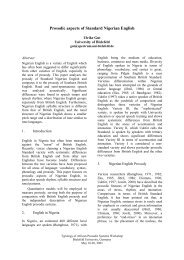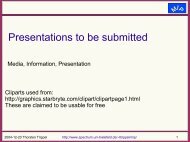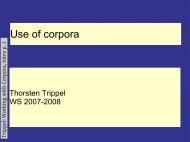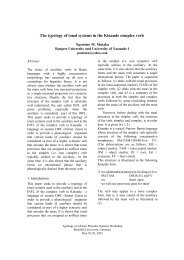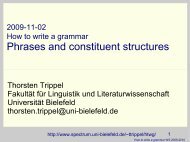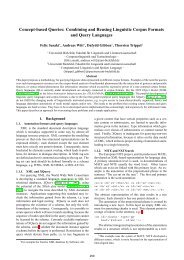The lexicon in syntax - Computational Linguistics and Spoken ...
The lexicon in syntax - Computational Linguistics and Spoken ...
The lexicon in syntax - Computational Linguistics and Spoken ...
Create successful ePaper yourself
Turn your PDF publications into a flip-book with our unique Google optimized e-Paper software.
2008-11-17<br />
How to write a grammar<br />
<strong>The</strong> <strong>lexicon</strong> <strong>in</strong> <strong>syntax</strong><br />
Thorsten Trippel<br />
Fakultät für L<strong>in</strong>guistik und Literaturwissenschaft<br />
Universität Bielefeld<br />
thorsten.trippel@uni-bielefeld.de<br />
http://www.spectrum.uni-bielefeld.de/~ttrippel/htwg/<br />
1<br />
How to write a grammar WS 2008-2009
Agenda<br />
● Heads <strong>and</strong> dependents<br />
● Adjuncts <strong>and</strong> complements<br />
● Some simple classes of grammars<br />
http://www.spectrum.uni-bielefeld.de/~ttrippel/htwg/<br />
2<br />
How to write a grammar WS 2008-2009
Heads <strong>and</strong> dependents<br />
•<br />
Phrase ≔ part of a clause cont<strong>in</strong>u<strong>in</strong>g a head<br />
•<br />
Head ≔ most important word <strong>in</strong> a phrase<br />
•<br />
Wordclass of head determ<strong>in</strong>es wordclass of phrase<br />
•<br />
Bears crucial semantic <strong>in</strong>formation<br />
•<br />
Has the same distribution as the entire phrase<br />
•<br />
Can (usually) not be omitted<br />
•<br />
Sometimes requires (a) complement(s)<br />
•<br />
Dependent part of the phrase which are not the<br />
≔<br />
head<br />
http://www.spectrum.uni-bielefeld.de/~ttrippel/htwg/<br />
3<br />
How to write a grammar WS 2008-2009
Generalization<br />
•<br />
Subject ≔the subject of a cluase is a phrase of<br />
one word or more which is headed by a noun<br />
(NP)<br />
•<br />
Predicate ≔ normally a VP; the VP can conta<strong>in</strong><br />
dependents<br />
•<br />
Heads <strong>in</strong>fluence<br />
•<br />
Determ<strong>in</strong>e dependents (which word classes are possible)<br />
•<br />
Agreement of dependents (gender, number, …)<br />
•<br />
Case determ<strong>in</strong>ation<br />
http://www.spectrum.uni-bielefeld.de/~ttrippel/htwg/<br />
4<br />
How to write a grammar WS 2008-2009
Adjuncts vs. complements<br />
Adjuncts ≔ optional additions to a head provid<strong>in</strong>g<br />
extra <strong>in</strong>formation<br />
Complements ≔ often obligatory phrases selected<br />
by the head<br />
http://www.spectrum.uni-bielefeld.de/~ttrippel/htwg/<br />
5<br />
How to write a grammar WS 2008-2009
Adjunct or complement? (see Tallerman, p. 104)<br />
•<br />
Optional vs. obligatory phrase<br />
•<br />
Adjuncts: always optional<br />
•<br />
Complements: often obligatory, esp. with prepositiosn,<br />
verbs; close relation with the head; selected by the head<br />
•<br />
Limited vs. unlimited number of dependent phrases<br />
•<br />
Possibly unlimited number of adjuncts<br />
•<br />
Strictly limited number of complements<br />
•<br />
Properties of PP dependents<br />
•<br />
Adjuncts: wide range of head prepostions<br />
•<br />
Complements: specific head prepositions<br />
•<br />
Decision impossible based on POS<br />
http://www.spectrum.uni-bielefeld.de/~ttrippel/htwg/<br />
6<br />
How to write a grammar WS 2008-2009
Head <strong>in</strong>itial or head f<strong>in</strong>al languages<br />
•<br />
Typological dist<strong>in</strong>ction<br />
•<br />
English: head <strong>in</strong>itial<br />
•<br />
In VP: NP complements after the V<br />
•<br />
In PP: NP after the P<br />
•<br />
How about NPs?<br />
•<br />
Head f<strong>in</strong>al languages:<br />
•<br />
Turkish<br />
•<br />
Japanese<br />
•<br />
...<br />
http://www.spectrum.uni-bielefeld.de/~ttrippel/htwg/<br />
7<br />
How to write a grammar WS 2008-2009
Ways of writ<strong>in</strong>g a grammar<br />
•<br />
“'ve been wait<strong>in</strong>g for this for ages...”<br />
•<br />
“Sure, how do you write a book”<br />
•<br />
“Is there more to grammar than 'It is correct to<br />
never split an <strong>in</strong>f<strong>in</strong>itive'?”<br />
http://www.spectrum.uni-bielefeld.de/~ttrippel/htwg/<br />
8<br />
How to write a grammar WS 2008-2009
What a grammar is supposed to<br />
provide:<br />
A full set of items describ<strong>in</strong>g all possible correct<br />
constructs of a language. (completeness)<br />
All other constructs should be classified as <strong>in</strong>correct<br />
by the grammar. (soundness)<br />
http://www.spectrum.uni-bielefeld.de/~ttrippel/htwg/<br />
9<br />
How to write a grammar WS 2008-2009
<strong>The</strong> simplest possible grammar: lists<br />
● No formalism<br />
● Easy to create<br />
● List all acceptable sentences:<br />
●<br />
●<br />
●<br />
●<br />
●<br />
●<br />
Language loses lots of <strong>in</strong>terest<strong>in</strong>g structures.<br />
Language loses lots <strong>and</strong> lots of <strong>in</strong>terest<strong>in</strong>g structures.<br />
Language loses lots <strong>and</strong> lots <strong>and</strong> lots of <strong>in</strong>terest<strong>in</strong>g structures.<br />
Some teachers try to get rid of more students.<br />
Some teachers try to get rid of more <strong>and</strong> more students.<br />
Some teachers try to get rid of more <strong>and</strong> more <strong>and</strong> more students.<br />
http://www.spectrum.uni-bielefeld.de/~ttrippel/htwg/<br />
10<br />
How to write a grammar WS 2008-2009
Imag<strong>in</strong>e....<br />
● ... a language of the "teacher" k<strong>in</strong>d<br />
● ... every other sentence some <strong>and</strong> teacher are reversed, i.e.:<br />
●<br />
●<br />
●<br />
●<br />
●<br />
Some teachers try to get rid of more students.<br />
Teachers some try to get rid of more <strong>and</strong> more students.<br />
Some teachers try to get rid of more <strong>and</strong> more <strong>and</strong> more<br />
students.<br />
Teachers some try to get rid of more <strong>and</strong> more <strong>and</strong> more<br />
<strong>and</strong> more students.<br />
*Some teachers try to get rid of more <strong>and</strong> more <strong>and</strong> more<br />
<strong>and</strong> more students.<br />
http://www.spectrum.uni-bielefeld.de/~ttrippel/htwg/<br />
11<br />
How to write a grammar WS 2008-2009
What we know...<br />
● <strong>The</strong>re are rules<br />
● Rules are not expressed <strong>in</strong> the lists (!)<br />
● Lists do not "capture a l<strong>in</strong>guistically significant<br />
generalization"<br />
● ...luckily there is no natural language where the<br />
structure depends on the number of words<br />
http://www.spectrum.uni-bielefeld.de/~ttrippel/htwg/<br />
12<br />
How to write a grammar WS 2008-2009
Regular expressions<br />
● Let's pretend:<br />
●<br />
<strong>The</strong>re are parts of speech/grammatical categories<br />
● Verbs, nouns, articles ...<br />
● Proposal: English grammar is<br />
●<br />
●<br />
●<br />
●<br />
●<br />
●<br />
●<br />
A list of patterns:<br />
ARTICLE NOUN VERB<br />
ARTICLE NOUN VERB ARTICLE NOUN<br />
A <strong>lexicon</strong>:<br />
ARTICLE: a, the<br />
NOUN: cat, dog<br />
http://www.spectrum.uni-bielefeld.de/~ttrippel/htwg/<br />
VERB: attacked, scratched<br />
13<br />
How to write a grammar WS 2008-2009
Possible sentences:<br />
<strong>The</strong> cat attacked.<br />
<strong>The</strong> cat scratched.<br />
A cat attacked.<br />
A cat scratched.<br />
<strong>The</strong> dog attacked.<br />
<strong>The</strong> dog scratched.<br />
A dog attacked.<br />
A dog scratched.<br />
A dog scratched a cat<br />
A dog scratched the cat.<br />
A dog scratched a dog.<br />
A dog scratched the dog.<br />
....<br />
= 40 comb<strong>in</strong>ations<br />
(2*2*2+2*2*2*2*2=40)<br />
Not possible to describe:<br />
Teachers some try to get rid of<br />
more <strong>and</strong> more students.<br />
http://www.spectrum.uni-bielefeld.de/~ttrippel/htwg/<br />
14<br />
How to write a grammar WS 2008-2009
Solution: Kleene star <strong>and</strong> plus<br />
Notation<br />
Named after Stephen Kleene<br />
Notation: * or + (superscripts)<br />
Mean<strong>in</strong>g<br />
*<br />
: 0 or arbitrary many (f<strong>in</strong>ite)<br />
+<br />
: 1 or arbitrary many (f<strong>in</strong>ite)<br />
Example:<br />
Some teacher get rid of more [<strong>and</strong><br />
more] * students<br />
Some teacher get rid of more [<strong>and</strong><br />
more] + students.<br />
ARTICLE NOUN VERB (ARTICLE<br />
NOUN)|ADJECTIVE *<br />
| denotes alternatives "or"<br />
() means optional<br />
http://www.spectrum.uni-bielefeld.de/~ttrippel/htwg/<br />
15<br />
How to write a grammar WS 2008-2009
A closer look at regular grammars<br />
patterns mak<strong>in</strong>g use of<br />
Kleene star (0 or more)<br />
Kleene plus (1 or more)<br />
parenthesis (optionality)<br />
NOUN (<strong>and</strong> NOUN) + chase a cat.<br />
NOUN (<strong>and</strong> NOUN) + VERB a cat.<br />
NOUN (<strong>and</strong> NOUN) + VERB a NOUN<br />
(<strong>and</strong> NOUN)*.<br />
DET ADJ NOUN (KONJ NOUN)<br />
VERB DET ADJ NOUN ((DET) KONJ<br />
ADJ NOUN)<br />
....<br />
Problem:<br />
how do you <strong>in</strong>dicate that DET ADJ<br />
NOUN is one “unit”?<br />
<strong>The</strong>se units are called phrases<br />
or (syntactic) constituents<br />
http://www.spectrum.uni-bielefeld.de/~ttrippel/htwg/<br />
16<br />
How to write a grammar WS 2008-2009
Context Free (Phrase Structure)<br />
Grammar<br />
● Conta<strong>in</strong>s rules: A→φ<br />
● Include phrases<br />
● Grammatical categories<br />
● Grammatical categories =<br />
● Parts of speech ('lexical<br />
category')<br />
●<br />
●<br />
● Types of phrase<br />
('nonlexical category' or<br />
'phrasal category')<br />
●<br />
● Conta<strong>in</strong>s a <strong>lexicon</strong>:<br />
● Words<br />
●<br />
A nonlexical category,<br />
φ regular expression<br />
from lexical <strong>and</strong>/or<br />
nonlexical category<br />
“→” means “can consist<br />
of<br />
Rules called phrase<br />
structure rules<br />
http://www.spectrum.uni-bielefeld.de/~ttrippel/htwg/<br />
17<br />
How to write a grammar WS 2008-2009
Example grammar<br />
Rules<br />
S→ NP VP<br />
NP → (D) A* N PP*<br />
VP → V (NP) (PP)<br />
PP → P NP<br />
Lexicon<br />
D: the, some<br />
A: big, brown, old<br />
N: birds, fleas, dog,<br />
hunter<br />
V: attack, ate, watched<br />
P: for, beside, with<br />
What do sentences look<br />
like?<br />
http://www.spectrum.uni-bielefeld.de/~ttrippel/htwg/<br />
18<br />
How to write a grammar WS 2008-2009
CFG as a tree<br />
S<br />
NP<br />
VP<br />
D A A N PP V NP PP<br />
P NP D N P NP<br />
D<br />
N<br />
<strong>The</strong> big brown dog with fleas watched the birds beside the hunter<br />
http://www.spectrum.uni-bielefeld.de/~ttrippel/htwg/<br />
19<br />
How to write a grammar WS 2008-2009
Oh wow, we have seen some of that<br />
before...<br />
•<br />
Branch<strong>in</strong>g <strong>in</strong>to phrases<br />
•<br />
Each phrase has a head<br />
•<br />
Some have adjuncts<br />
•<br />
Some have complements<br />
•<br />
Some have arguments<br />
http://www.spectrum.uni-bielefeld.de/~ttrippel/htwg/<br />
20<br />
How to write a grammar WS 2008-2009
Def<strong>in</strong>ition of grammar<br />
● A Grammar G = consists of<br />
●<br />
an alphabet Φ of non term<strong>in</strong>al symbols (or<br />
variables)<br />
● an alphabet Σ of term<strong>in</strong>al symbols, where Φ∩Σ =∅<br />
● a set R ⊆ Γ<br />
*<br />
‧ Γ *<br />
of replacement rules (mapp<strong>in</strong>gs)<br />
, where Γ is the complete alphabet Φ⋃Σ <strong>and</strong><br />
α ∉ Σ *<br />
● a start symbol S ∈ Φ<br />
● Rules are pairs of , usually written α→β<br />
● Unrestricted http://www.spectrum.uni-bielefeld.de/~ttrippel/htwg/<br />
(general) grammar (Type 0 grammar) 21<br />
How to write a grammar WS 2008-2009
Example grammar (rep.)<br />
Rules<br />
S→ NP VP<br />
NP → (D) A* N PP*<br />
VP → V (NP) (PP)<br />
PP → P NP<br />
Lexicon<br />
D: the, some<br />
A: big, brown, old<br />
N: birds, fleas, dog, hunter<br />
V: attack, ate, watched<br />
P: for, beside, with<br />
http://www.spectrum.uni-bielefeld.de/~ttrippel/htwg/<br />
Term<strong>in</strong>als: words <strong>in</strong> the<br />
<strong>lexicon</strong><br />
Non-term<strong>in</strong>als: NP, VP,<br />
PP, D, A, V, P, N...<br />
Rules<br />
Start symbol: S<br />
22<br />
How to write a grammar WS 2008-2009
Def<strong>in</strong>ition of language<br />
● Let G = be a grammar. <strong>The</strong>n<br />
● L(G) = {w ∈Σ* | S ⇒* W} is called the language<br />
generated by G.<br />
● Two grammars are equivalent if they generate the<br />
same language<br />
http://www.spectrum.uni-bielefeld.de/~ttrippel/htwg/<br />
23<br />
How to write a grammar WS 2008-2009
<strong>The</strong> Chomsky Hierarchy<br />
● Type 0: unrestricted grammar (see also determ<strong>in</strong>istic <strong>and</strong><br />
non determ<strong>in</strong>istic Tur<strong>in</strong>g mach<strong>in</strong>es)<br />
● Type 1: context sensitive grammars<br />
● Type 2: context free grammars<br />
● Type 3: regular language/regular grammars<br />
http://www.spectrum.uni-bielefeld.de/~ttrippel/htwg/<br />
24<br />
How to write a grammar WS 2008-2009
Homework<br />
•<br />
Take the sentences from your last homework<br />
•<br />
Use the simple sentences/ma<strong>in</strong> clauses, relative clauses<br />
only<br />
•<br />
List all term<strong>in</strong>al symbols!<br />
•<br />
Determ<strong>in</strong>e all phrases!<br />
•<br />
Where is your start symbol?<br />
•<br />
Can you draw a <strong>syntax</strong> tree for them?<br />
http://www.spectrum.uni-bielefeld.de/~ttrippel/htwg/<br />
25<br />
How to write a grammar WS 2008-2009


